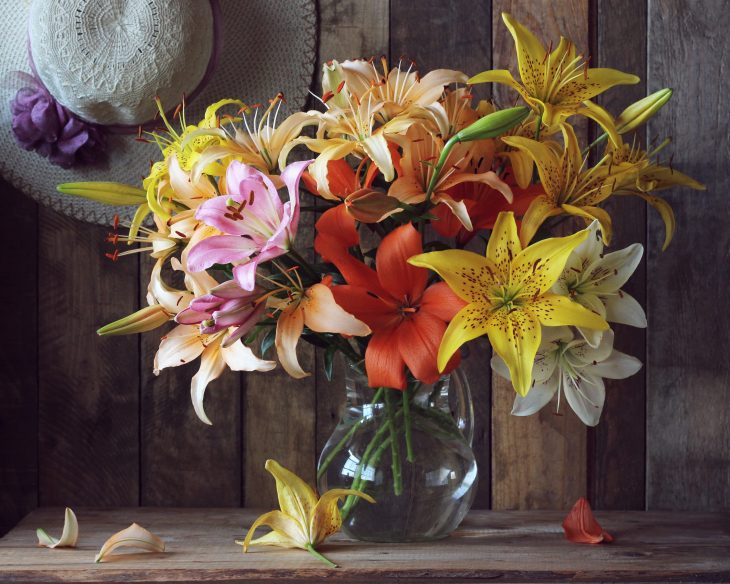
Lilies are one of the most popular flowers in the world as they’re great for gardens, home interiors, and even as gifts. People loved lilies so much that they developed more types of lilies by making hybrids!
If you’re curious about the different types of lilies, their meanings, characteristics, and more, then keep on reading for a comprehensive guide!
What are lilies?
Before diving into the different types of lilies, it’s important to define lilies first. Lilies, or true lilies, refer to flowering plants under the genus Lilium. They are herbaceous plants, and they usually have narrow leaves.
Most lilies are tall, ranging from 2 to 6 ft in height. Their flowers grow from bulbs, and they come in different colors and patterns. Because of their colorful appearance, lilies are often popular choices for home decorations and gardens. Lilies are also very fragrant, making them a favorite household ornament for many.
Some plants are also called lilies despite not belonging to this genus. Some examples include daylilies and calla lilies. They aren’t true lilies, but their flowers could definitely fool some.

How many types of lilies are there?
There are so many types of lilies that even expert gardeners get confused. In fact, there are around 100 species of lilies, so it’s no surprise people often get them mixed up! To make it easier, however, researchers categorized lilies into nine major divisions.
These nine divisions are the Asiatic lilies, Longiflorum lilies, Martagon lilies, Oriental lilies, Trumpet lilies, Candidum hybrid lilies, American hybrid lilies, Interdivisional hybrid lilies, and Species lilies.
Under these nine divisions are lily types that are similar in history, appearance, temperament, and other factors. Despite these similarities, however, these types of lilies still differ from one another in several ways.
Asiatic Lilies
A division of lilies is Asiatic lilies. Asiatic lilies usually have smaller flowers, but the blooms have beautiful patterns. Often, Asiatic lilies grow three to six flowers per stem, which are usually strong and straight.
Most types of Asiatic lilies do not have scents, which is great for those with sensitive noses. If you live in an area with wild animals, however, it might not be a good idea to leave your garden unfenced. Deer and rabbits love Asiatic lilies, so they might eat up your entire garden of lilies if you don’t keep them away.
Black Out Lily
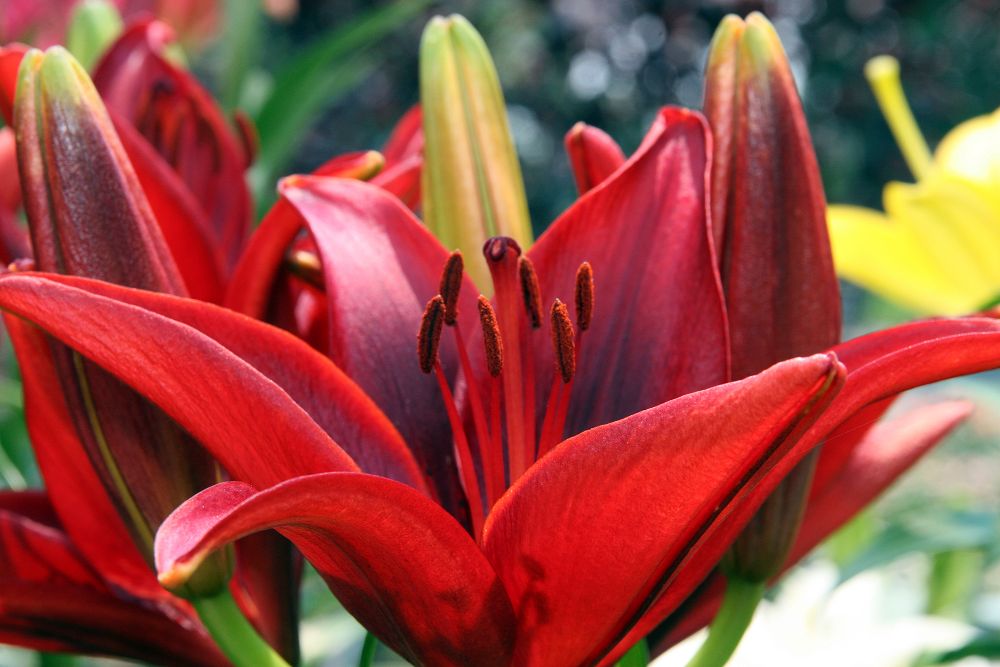
If you’re a fan of the color red, then this next hybrid might be the one for you! Lilium “Black Out” or the Black Out lily is one of the darkest red lilies ever. It has large, dark red flowers with reddish-black accents near the center of the petals.
Compared to other types of lilies, this plant is shorter, growing up to 2 to 3 ft. tall. They thrive under the full sun and with moist soil, as they bloom around early to midsummer. The best time to plant them in your garden is during the fall or early spring. So if you want to plant Black Out lilies in a pot, do so any time between spring and fall.
Either way, Black Out lilies are great statement pieces because of their bold and elegant appearance. In gardens, they are often used as border plants. These lilies are also low maintenance, which makes them great for beginner gardeners!
Black Spider Lily
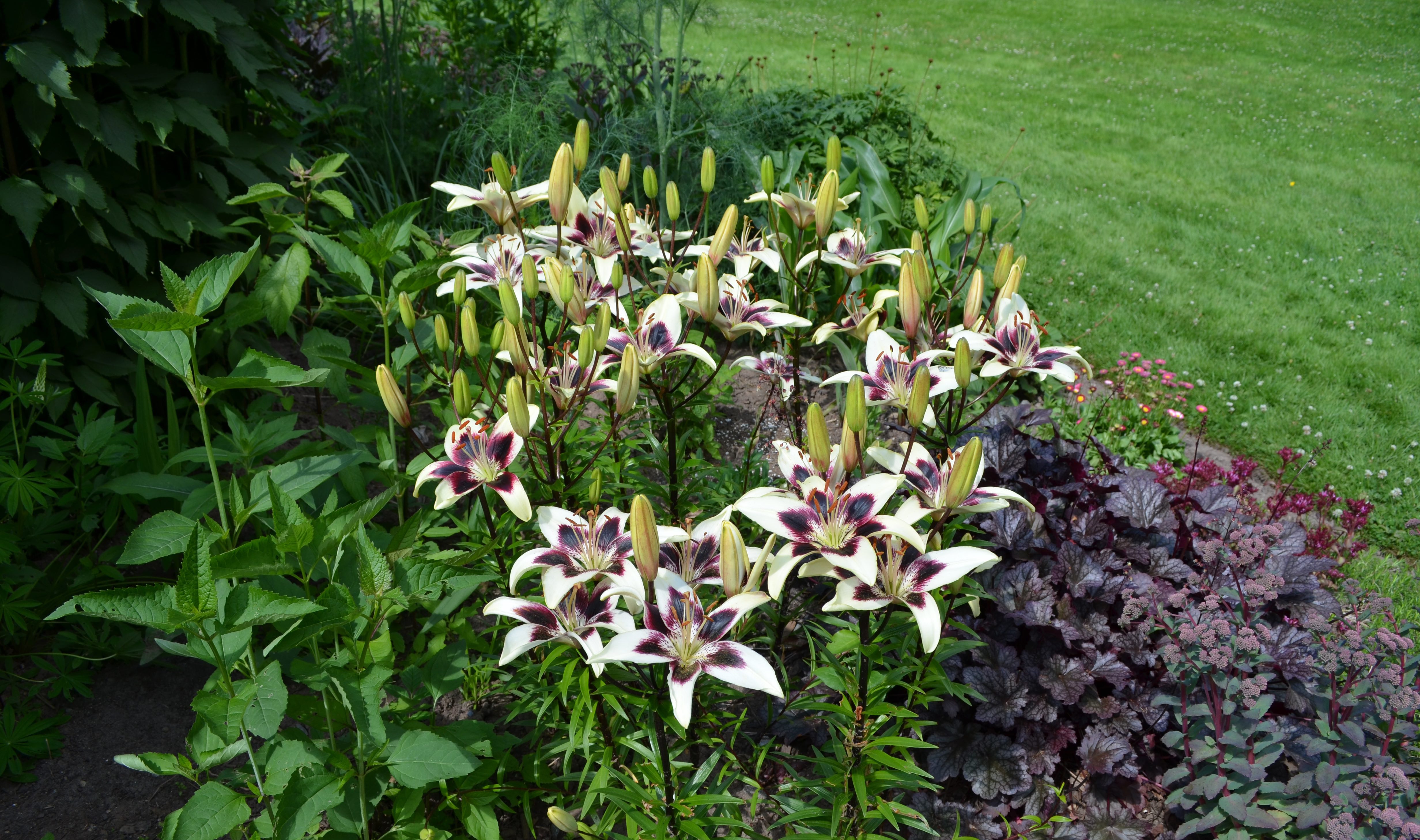
Next on this type of lilies list is the Black Spider Lily. Black Spider lilies are creamy-white flowers with burgundy to black spots near the center. They grow up to 2 to 3 ft. tall and bloom in the summer months.
Like most Asiatic lilies, this hybrid is also a great border plant. Each stem of this plant produces around 5 to 7 flowers. Clustered together, Black Spider lilies are very eye-catching. They also attract a lot of bees and butterflies, which can help your flowers bloom.
Unfortunately, this hybrid is not for cat owners since Black Spider lilies are toxic to felines. To dogs and other household pets, however, the Black Spider lily is perfectly safe.
Citronella Lily
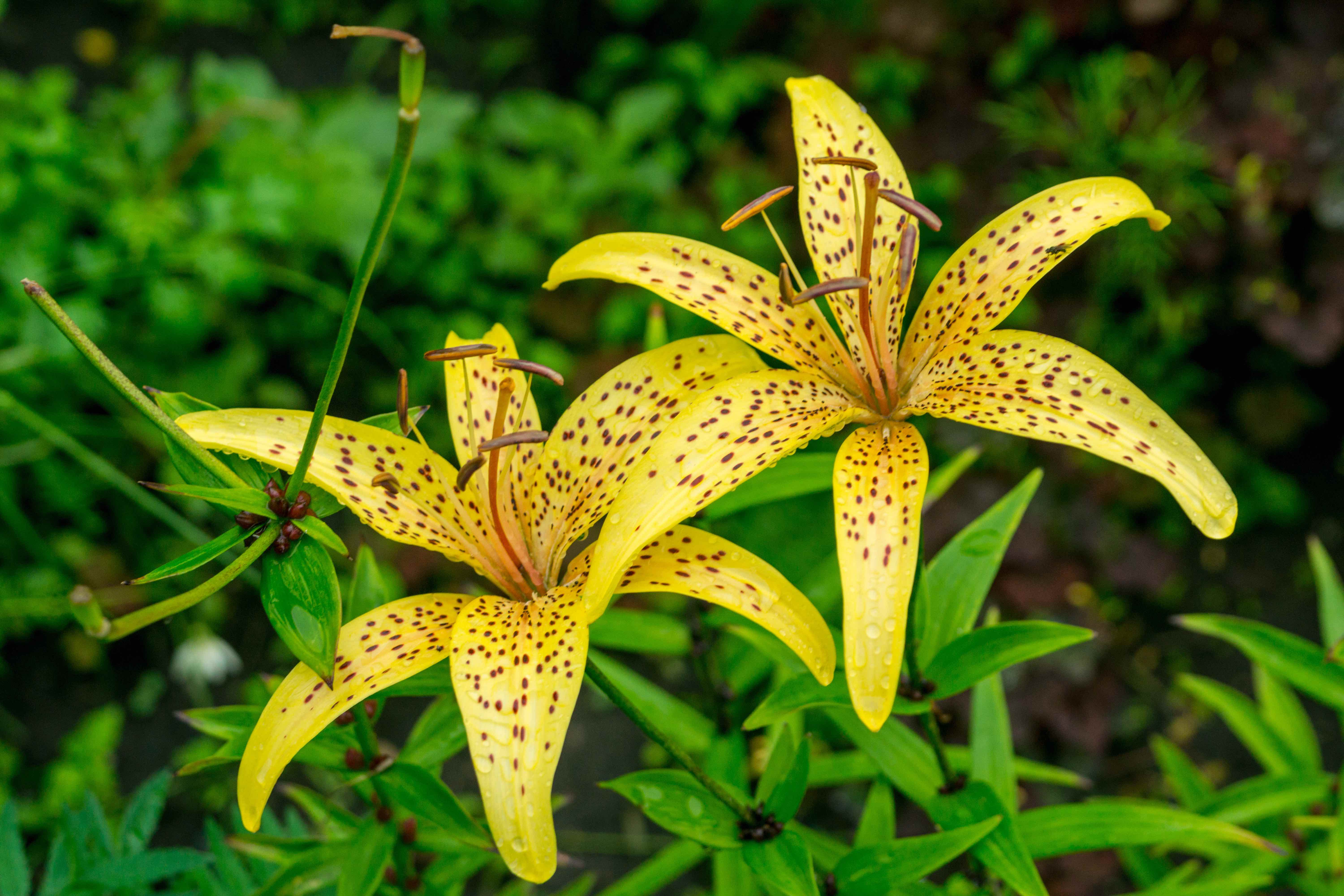
If you’re looking for lilies to brighten up your home, then the Citronella lily is a superb choice!
Citronella lilies are golden yellow with spotted recurved petals. Their unique bulbs face downward, unlike most types of Asiatic lilies.
Citronella lilies bloom in the summer, and they grow up to 3 to 5 ft. tall. These low-maintenance plants are great borders for gardens and potted plants too. Each stem produces up to 20 blossoms, so expect a cluster of Citronella lilies when they fully bloom!
Forever Susan Lily
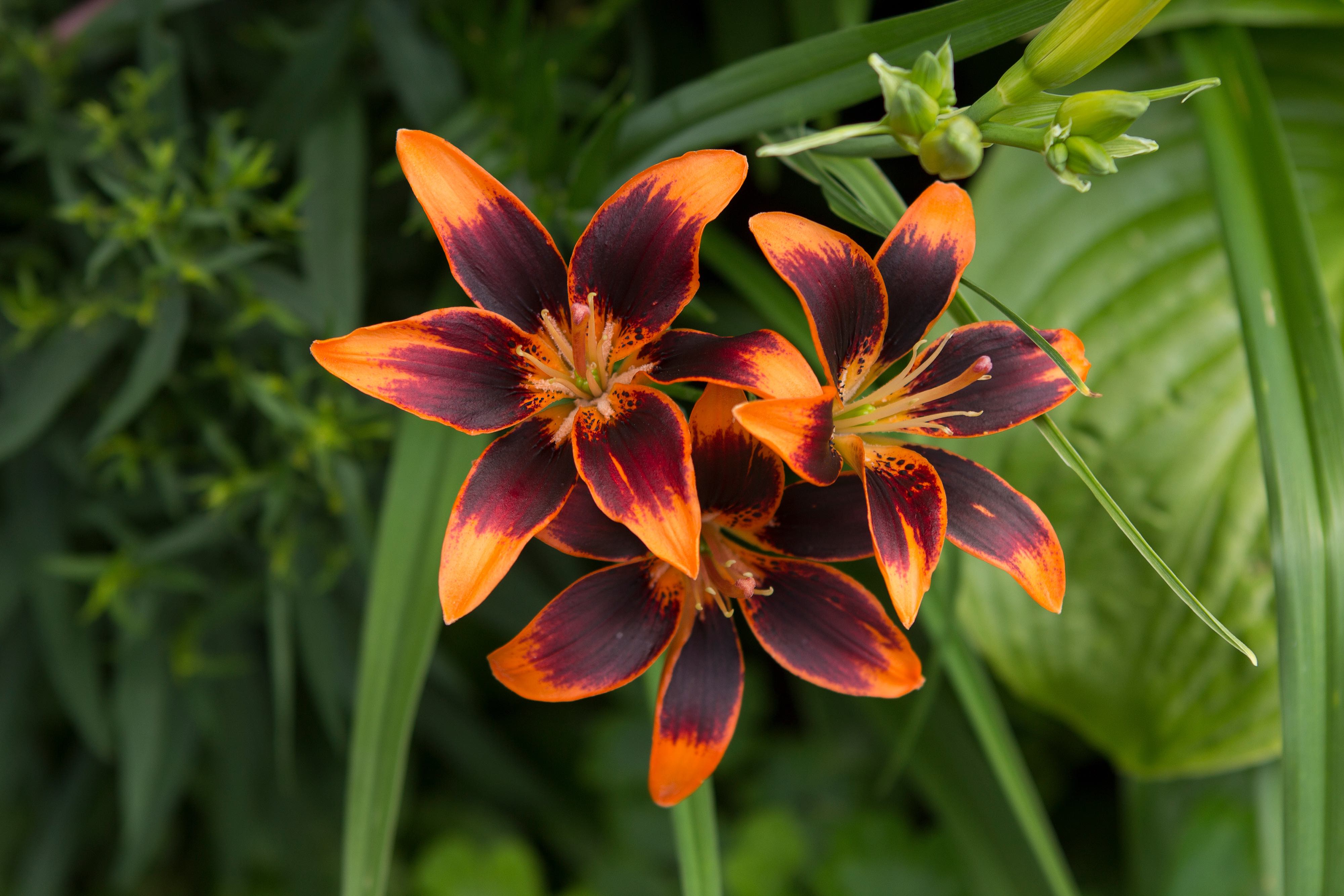
This next Asiatic lily has a fiery appearance. The Forever Susan Lily is a deep burgundy lily with bright yellow to orange edges. During summer, this lily flower blooms upward, facing the sun. At full height, its stem grows up to 2 to 3 ft. tall.
This hybrid is a scene-stealer, so people often use Forever Susan lilies for walkways, entryways, and centerpieces. They also thrive in pots, but their flowers grow smaller than in soil.
Planting them in your garden will attract pollinators, which will also help your other garden flowers receive pollen from bees.
Heartstrings
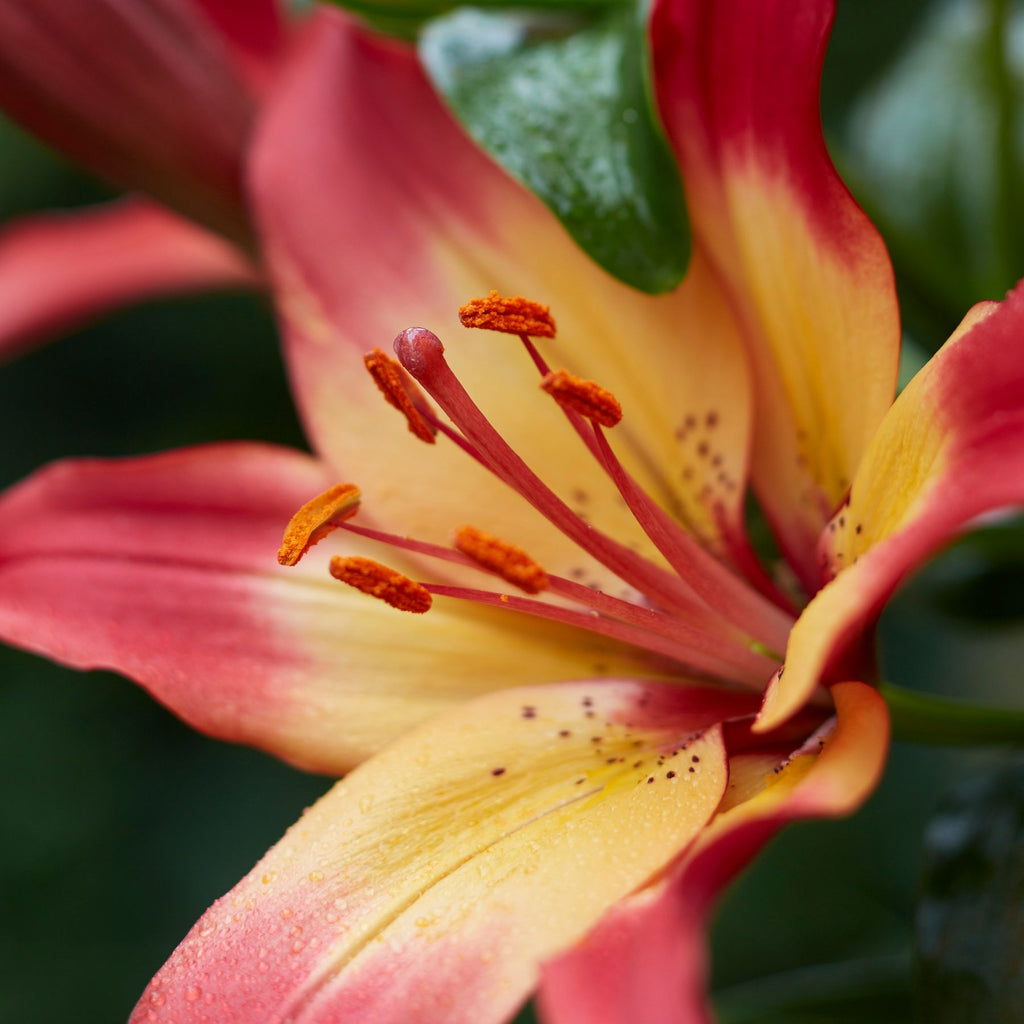
There is no shortage of colorful types of lilies, and Heartstrings lilies are proof. Heartstrings are Asiatic lilies that produce bright yellow petals with pink tips. Each stem has three to five flowers, and they bloom in early to midsummer.
Heartstrings are popular cut flowers. Cut flowers refer to flowers cut from their mother plant. They have no roots, but some are left with some stem and leaves. Cut flowers are what you often see in vases, bouquets, and other flower arrangements.
Aside from bouquets, florists also use Heartstrings for gardens and landscaping. The yellow and pink hues of Heartstrings blend well with other summer flowers.
Lollipop Lily
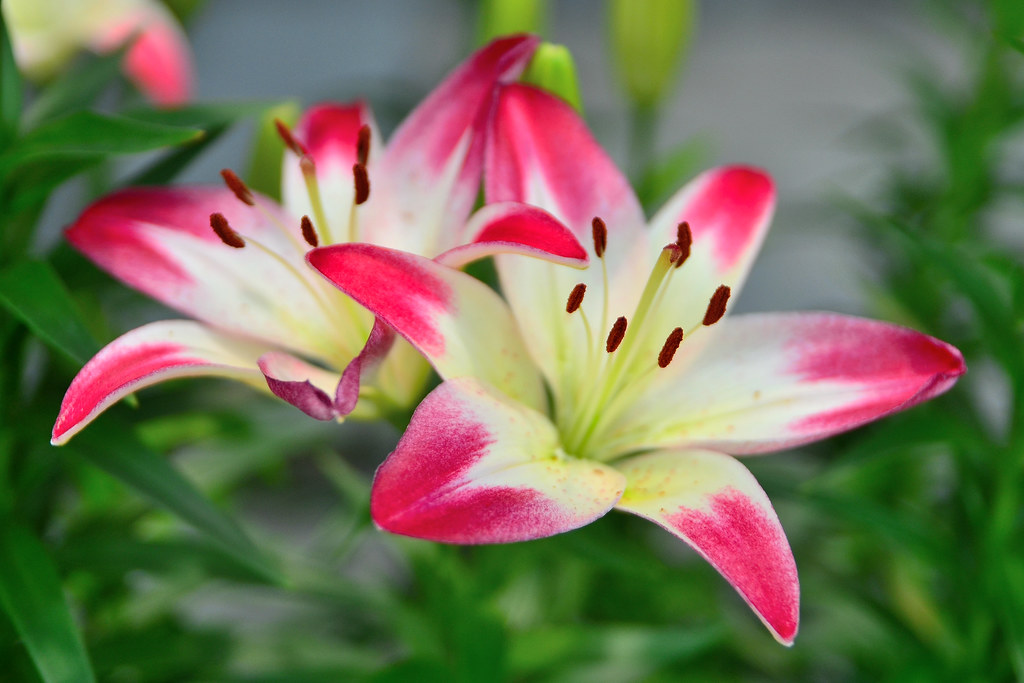
The Lilium Lollipop, sometimes called Lilium “Lollypop”, is another two-tone flower. Its petals are white with raspberry pink tips. Like most Asiatic lilies, the Lollipop lily produces large flowers that face upward.
As a summer plant, the Lollipop lily thrives under the full sun, but it can manage under partial shade. Lollipop lilies grow outdoors in certain regions of Alabama, Alaska, Arkansas, and California.
Unfortunately, this hybrid is toxic to both cats and dogs. However, there are plenty of other types of lilies that pet owners can still choose from!
Longiflorum Lilies
During Easter, you might notice a surge in white lilies at the flower shop. These types of lilies are Longiflorum lilies, and they are usually sold as a holiday ornament.
Because of this, florists often plant Longiflorum lilies earlier than in their season. They expose the flower bulbs to specific conditions to force the lilies to bloom in time for Easter.
Longiflorum lilies are white, with the flowers facing outward like a trumpet. Compared to other types of lilies, it is a little shorter, growing up to only 1 to 3 feet tall. They have a mild smell, and they are hardy plants that can survive through winter with the proper care.
Easter Lily
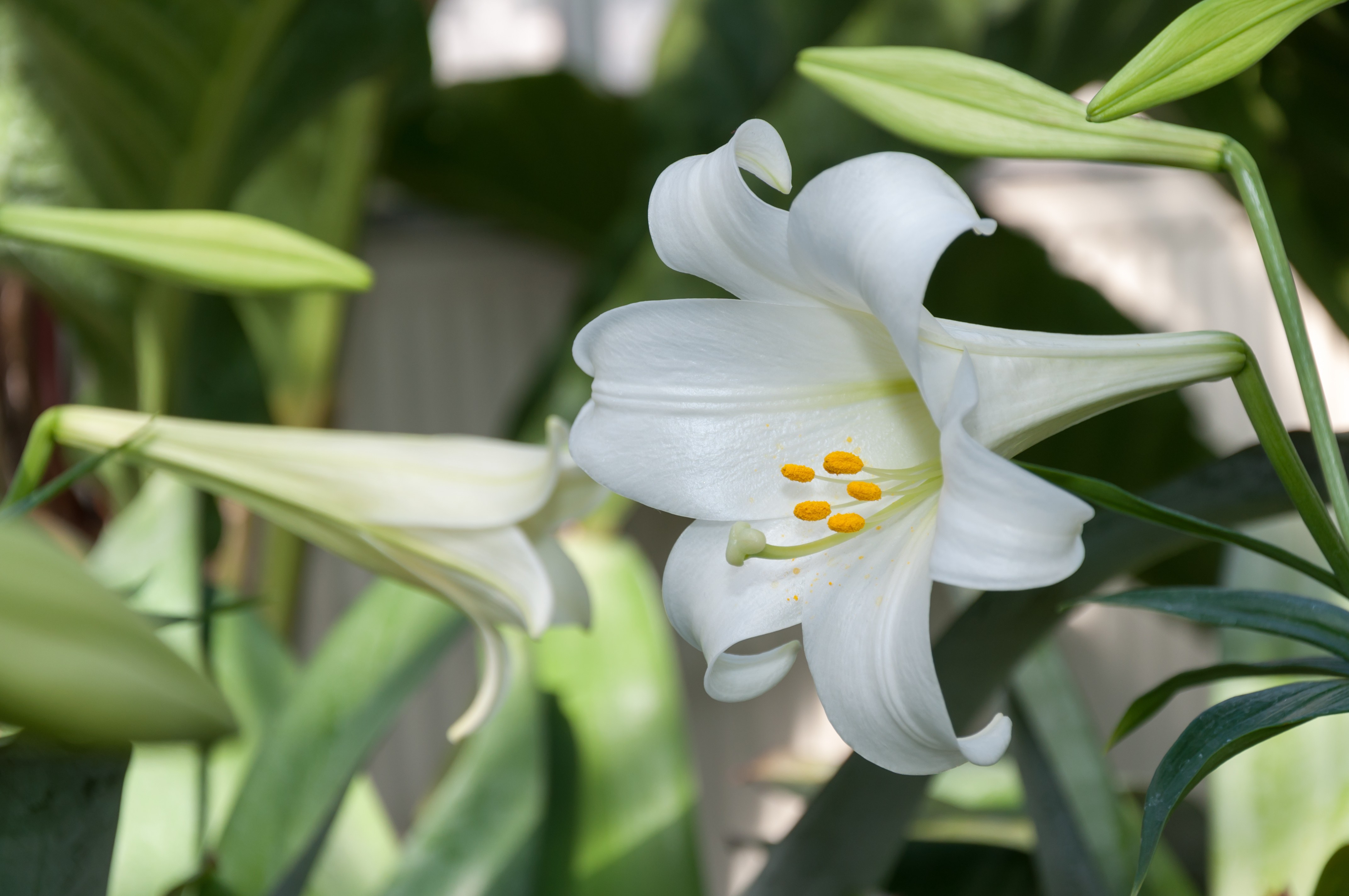
The Easter lily is not only the most popular of this division, but it is also the parent lily of other types of Longiflorum lilies. This lily is a lovely, pure white. Aside from its simple yet elegant appearance, the Easter lily is also very fragrant.
Easter lilies are popular cut flowers. Churches, schools, and some establishments often use them as decorations during the Easter holidays.
Compared to other types of lilies, Easter lilies are not as hardy. They are usually grown in containers instead of garden soil. While they are native to Japan and Taiwan, most Easter lilies from the commercial market are from North America.
White America
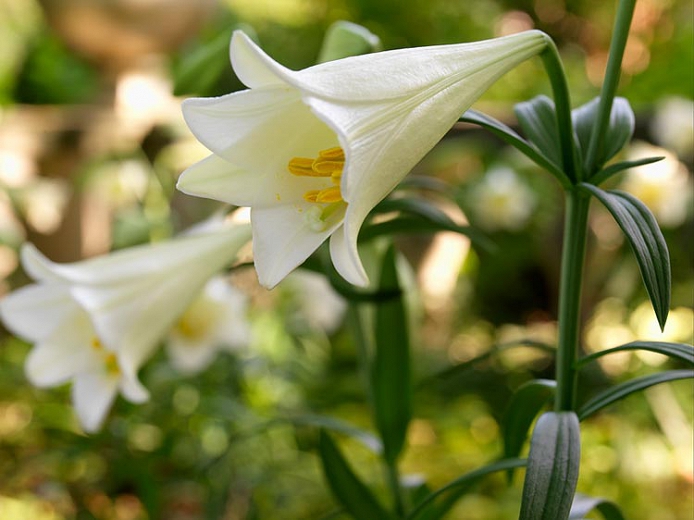
Another popular Longiflorum lily is the White America lily. White America lilies, sometimes “White American” lilies, are white trumpet-shaped flowers with yellow anthers. Each stem produces around eight flowers, and they measure 5 inches wide at full bloom.
They look like Easter lilies, but a closer look can help you distinguish the two hybrids apart. White America lilies have pale green tips on their petals.
This hybrid can be toxic to cats, so cat owners will have to opt for other types of white lilies instead.
Martagon Lilies
The next division is Martagon lilies. Martagon lilies comprise hybrids with small flowers facing downward. These flowers also grow in dozens, and they come in different colors and patterns like spotted petals.
Martagon hybrids are also quite tall as lilies under this division grow up to 6 ft. tall. They are also quite fragrant, which makes them perfect if you’re looking for something to freshen up your living room!
In the garden, however, it might be hard to grow Martagon lilies. They take a while to adjust to new surroundings, so be sure to pay extra attention to them during their first few weeks in their new home.
Arabian Knight
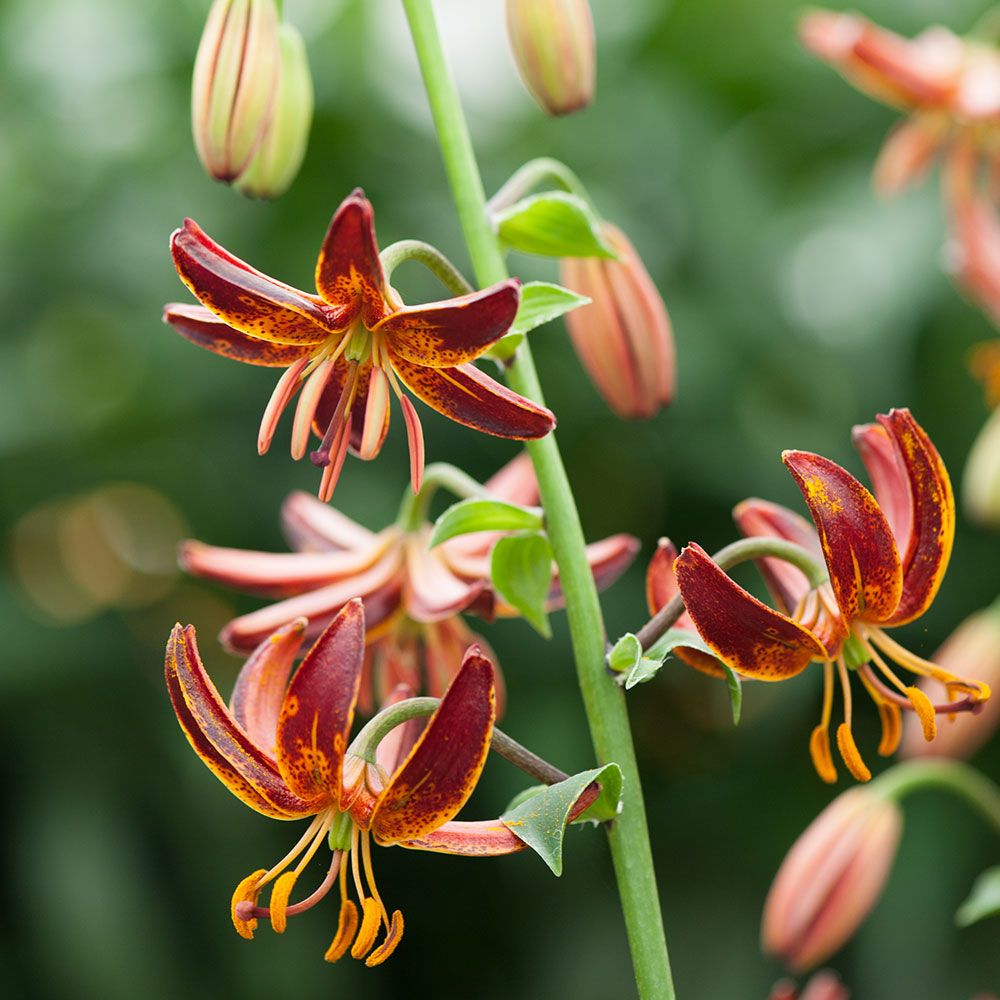
The Arabian Knight might not be as popular as other types of lilies, but they are certainly one of the most prolific. Arabian Knight lilies can produce up to 50 flowers per stem!
These flowers aren’t huge, but they will surely still catch your attention. They have golden upturned petals with dark mahogany spots – a dramatic look that makes them great statement pieces.
While Arabian Knight lilies take around a year to adjust to new soil, they are quite low maintenance. They can self-seed, and they bloom every year. Plus, they rarely catch diseases. Once they’ve settled in your garden, these lilies only need moist soil and full sun to thrive.
Claude Shride

Contrary to popular belief, not all types of lilies that bloom in the summer have bright sunny colors. For those who prefer darker shades, there’s always the Claude Shride lily to consider!
Claude Shride lilies range from dark red to deep brown. Most flowers have orange spots on their petals. This plant grows up to 4 to 6 ft. tall, and they bloom yearly in early to midsummer.
Outside of the flowering season, Claude Shride lilies will turn yellow. Simply trim yellow leaves and stems so they can be ready for the next summer.
Manitoba Morning
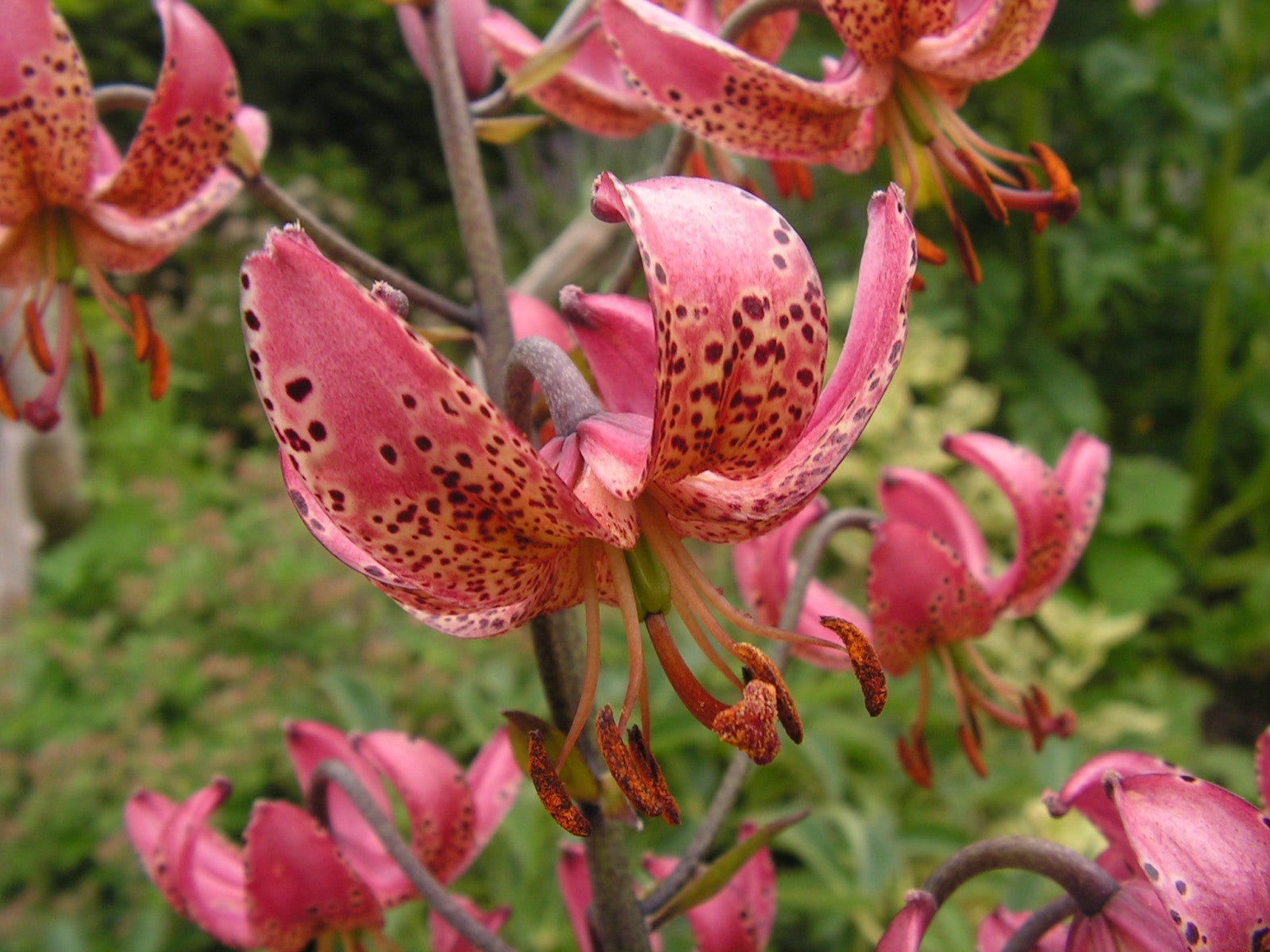
One of the most eye-catching types of lilies is the Manitoba Morning lily. The Manitoba Morning lily is a Martagon lily with pink blossoms. The flowers have shades of yellow around the center and dark mahogany spots all over their petals.
Like its hybrid sisters, Manitoba Morning lilies are very prolific. They produce 50 flowers per stem. Clustered together, these lilies resemble a chandelier with their upturned petals.
These lilies are naturalizing, which means they can adapt well in regions they are not native to. They bloom in the summer, but they also do well in cold and wet winters. Manitoban Morning lilies also thrive in both gardens and pots.
Turk’s Cap
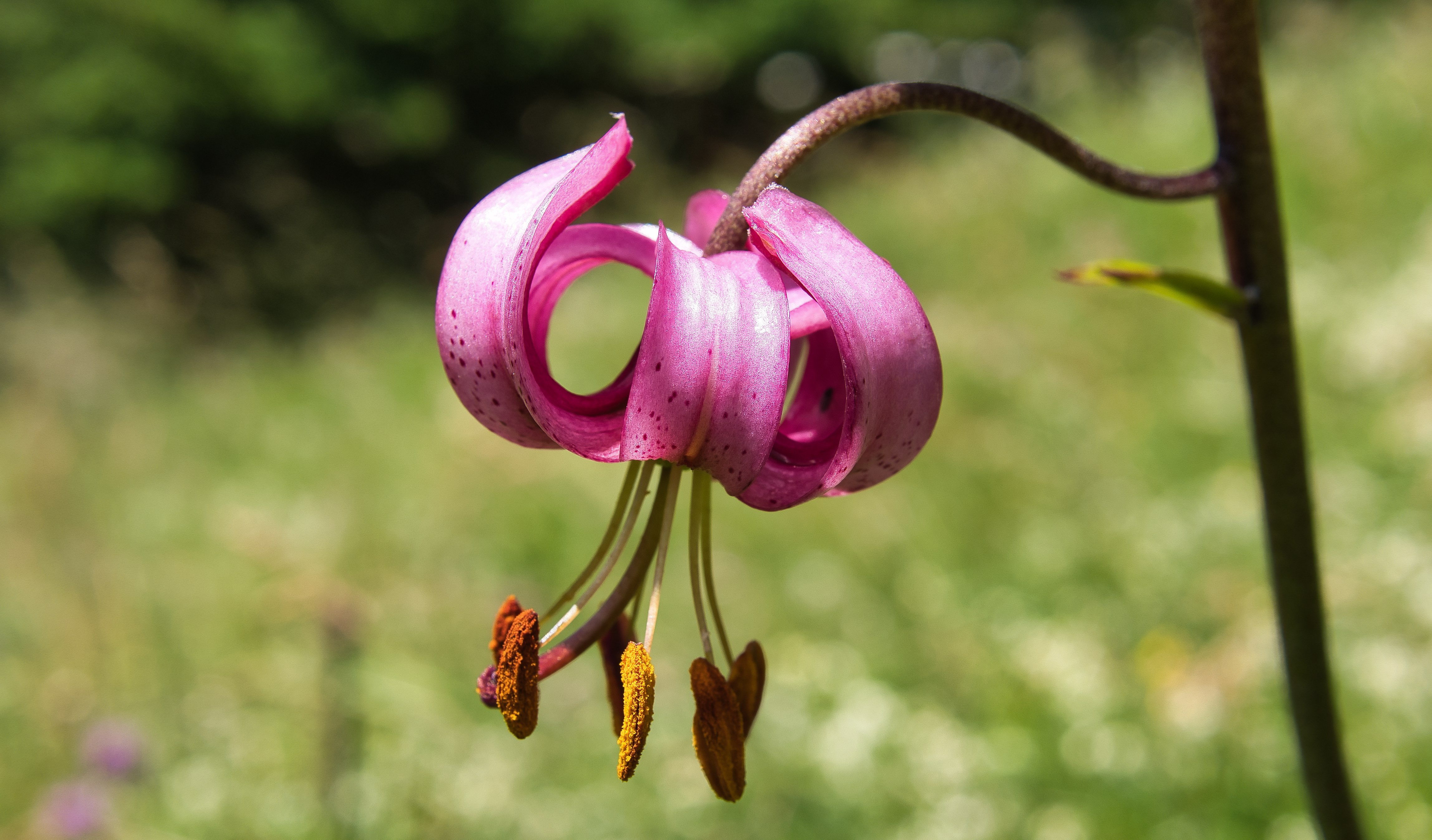
This hybrid is one of the most famous types of lilies under the Martagon division. In fact, people often think of Turk’s Cap lilies first when they hear Martagon lilies.
As the name suggests, the shape of their blossoms looks like a cap. Turk’s Cap lilies are small flowers that face downward with upturned petals. They come in a variety of colors, such as pink, white, and orange. Most Turk’s Cap lilies also have dark spot patterns.
These lilies are native to Europe and Asia, and they bloom from mid to late summer. They are the most shade tolerant lilies, but they still thrive the most under the full sun.
Oriental Lilies
If you’re looking for the most fragrant lilies, then the answer is likely in the Oriental lilies division. Compared to other types of lilies, Oriental lilies have the strongest scent, and they often smell strongest at night. Because of their fragrance, Oriental lilies are the most popular cut of flowers. In fact, you might see a lot of Valentine’s Day bouquets with these flowers.
Oriental lilies have broad leaves, produce large flowers, and grow up to 5 ft. tall. Most Oriental lilies produce a lot of pollen, and their flowers face up toward the sun. Oriental lilies are also popular garden flowers because of their sturdiness. They bloom around the end of summer and can survive during the fall.
Casa Blanca
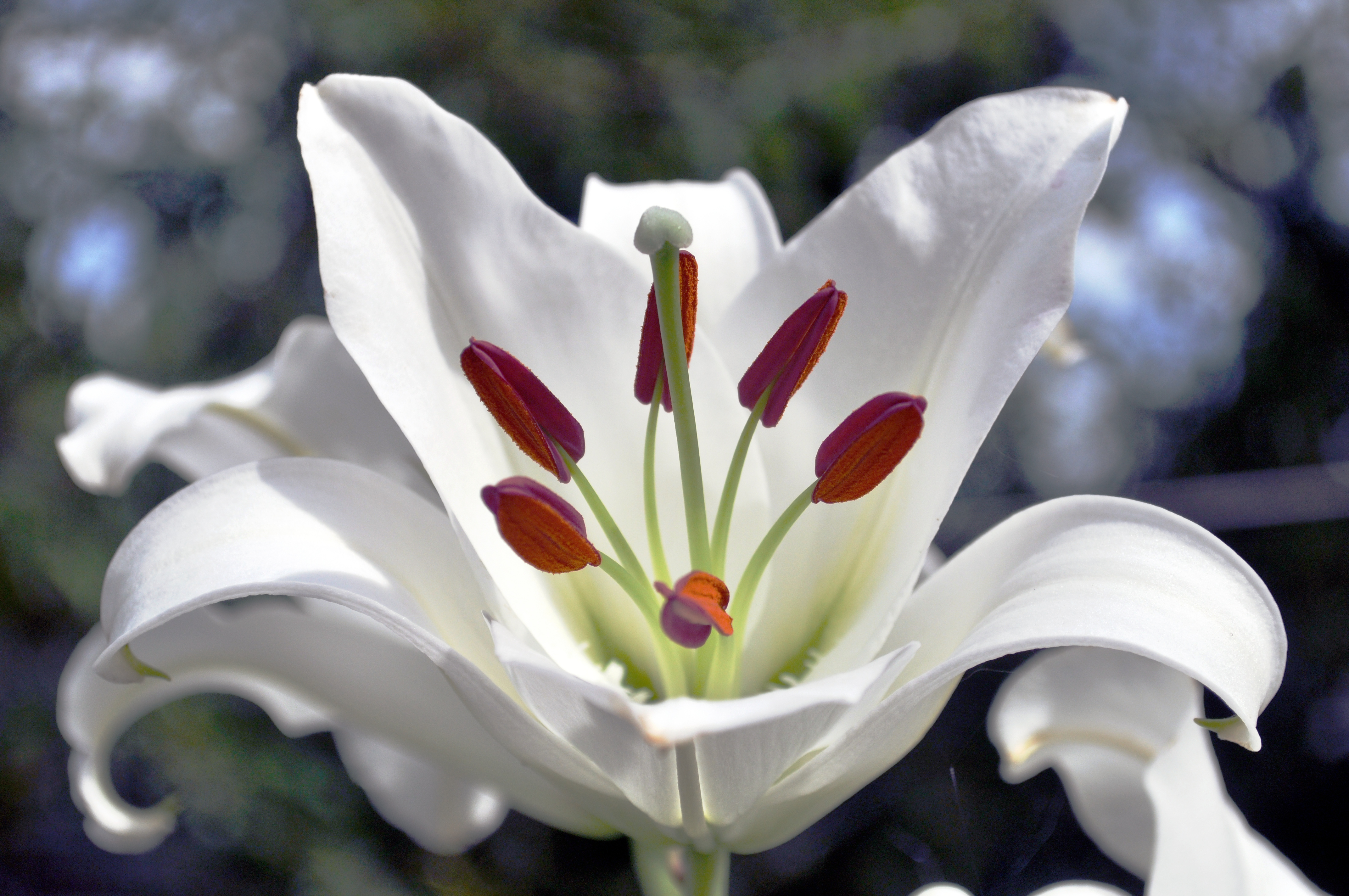
The Casa Blanca lily is a large, white lily. It faces outward with recurved petals. While Martagon lilies looked like candelabra, the Casa Blanca lily looks like a fancy bowl.
Casa Blanca lilies grow up to 3 to 4 ft. tall, and they produce six to eight blossoms per stem. They bloom from mid to late summer. They attract many bees and butterflies, which makes them ideal flowers to have in your garden.
For most professionals, the Casa Blanca is the “best white Oriental Lily ever” ever. In fact, in 1993, this hybrid won the Royal Horticultural Society’s “Award of Garden Merit” against different types of lilies.
Casa Blanca lilies are non-toxic to most household pets, except cats.
Dizzy
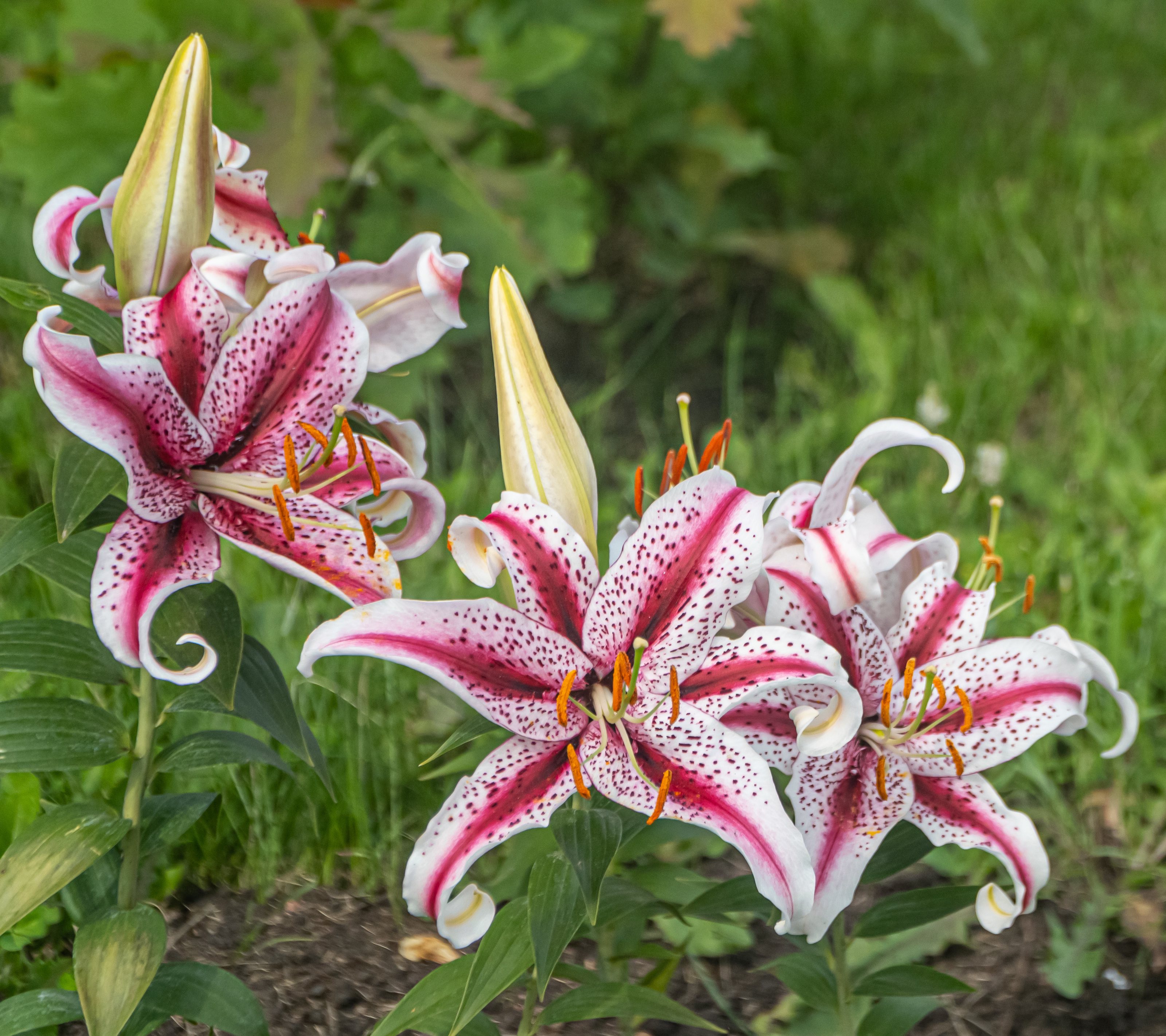
In this division, there are plenty of exotic types of lilies to choose from. Dizzy lily, for instance, is another showy Oriental lily. This flower has large white flowers with pink to red stripes down the middle of each petal, with red spots scattered all over.
Dizzy lilies are very fragrant, and their scent stays strong throughout the entire season. This flower blooms in mid to late summer, and it thrives under full sun. Like most Oriental lilies, Dizzy lilies are not fussy about soils, so they are easy to take care of.
Unfortunately, Dizzy lilies are among the types of lilies that are toxic to cats. To other animals, however, Dizzy lilies are harmless.
Muscadet Lily
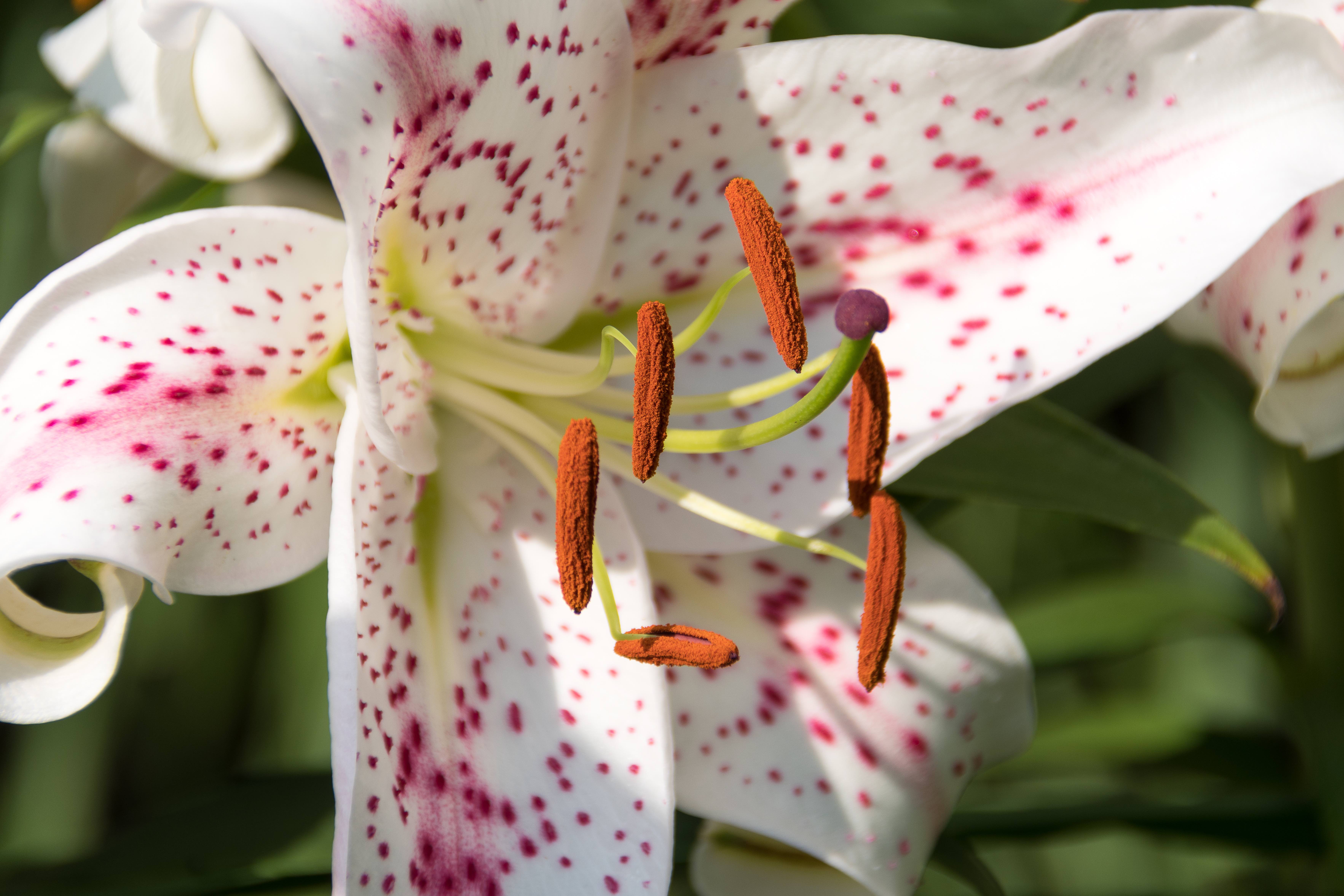
The Oriental Lily “Muscadet”, or simply Muscadet lily, is a large, white flower with pink stripes running down the middle of each petal. With outward-facing and ruffled petals, the Muscadet lily has a classic, elegant look that many people love.
Muscadet lilies are not only fragrant, but their scent is also long-lasting. Its fragrance stays strong upon blooming in the mid-late summer until the end of its season. During its blooming period, you can expect a lot of bees and butterflies to visit your garden.
Like most Oriental lilies, Muscadet lilies are quite easy to grow. All a Muscadet lily needs to thrive are well-drained soil and full sun exposure.
Stargazer Lily

One of the most popular types of lilies is the Stargazer lily. This Oriental lily is as showy as can be with its color tones and petal shape.
Stargazer lily flowers are a mix of pink, red, and white, with dark spots along the center of the petals. Its petals have relaxed tips, and its anthers are large and orange. With its elegant appearance, the Stargazer lily is a popular choice for floral arrangements. However, its pollen can stain clothes and skin, so it is best to cut off the anthers for garlands or corsages.
This Oriental lily, however, is not just popular with humans. Deer, rabbits, and other pests love to nibble on these flowers. If you live near areas where these animals roam freely, then consider fencing your garden to keep your flowers safe.
Tigermoon Lily
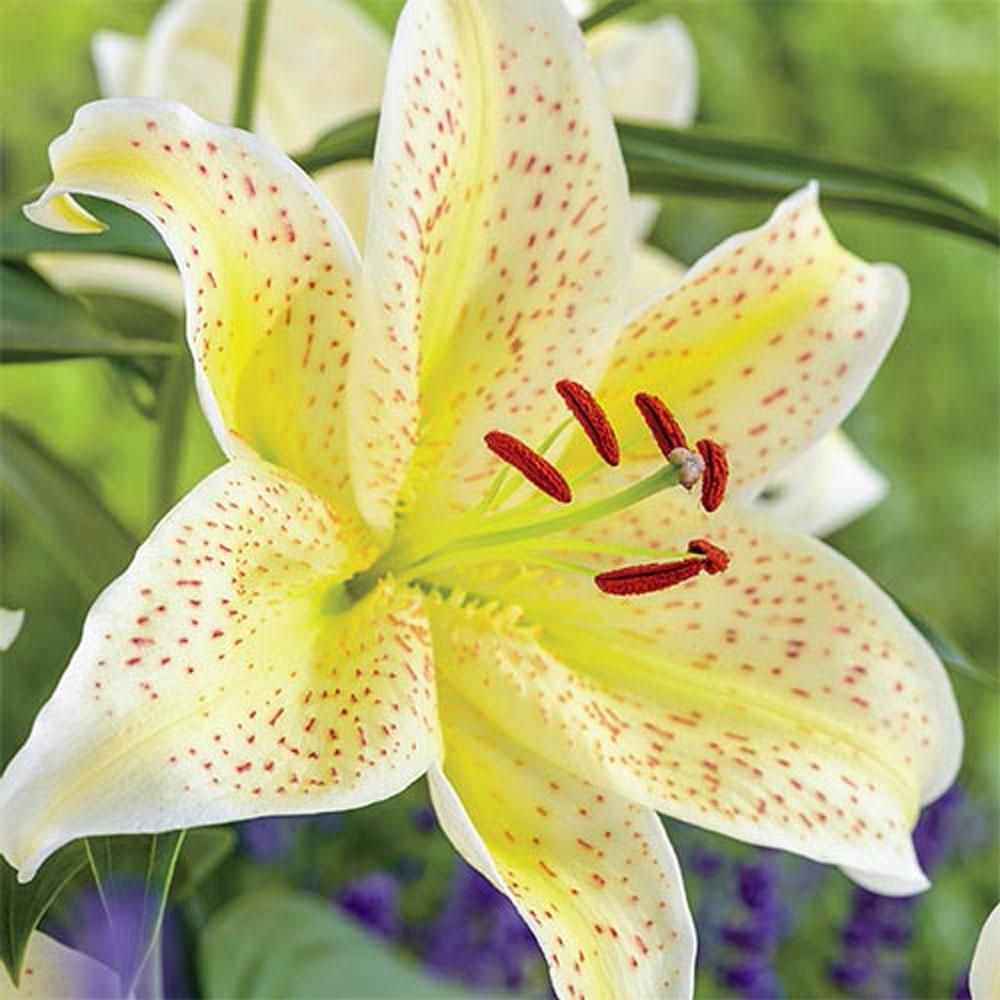
One of the largest types of lilies is the Tigermoon lily. In full bloom, this lily flower measures up to 9 inches!
Aside from its size, the flower’s colors are also eye-catching. The Tigermoon lily is pure white, with warm yellow around its center. Its name comes from the dark red spots littered across its petals, similar to a tiger’s fur.
One interesting fact about the Tigermoon lily is its original name was actually “Yellow Tiger”. However, in 2017, it was officially renamed the Tigermoon lily. Today, however, many still fondly call this flower “Yellow Tiger” along with other nicknames like the “Cat’s Eye”.
Trumpet Lilies
This next division is the largest group, and it comprises the most common types of lilies. In fact, when people think of lilies, they often have the image of a trumpet lily in mind.
As the name suggests, Trumpet lilies produce large, trumpet-shaped flowers. These flowers are usually colorful, with no spots or patterns. They have broad leaves, and their stems can grow up to 6 ft. tall.
These colorful flowers bloom in the summer, making their bright colors perfect for the season. During colder seasons, however, Trumpet lilies don’t do well. They will most likely not make it through cold and wet climates unless they are transferred indoors.
People also call Trumpet lilies “Aurelian lilies”.
African Queen
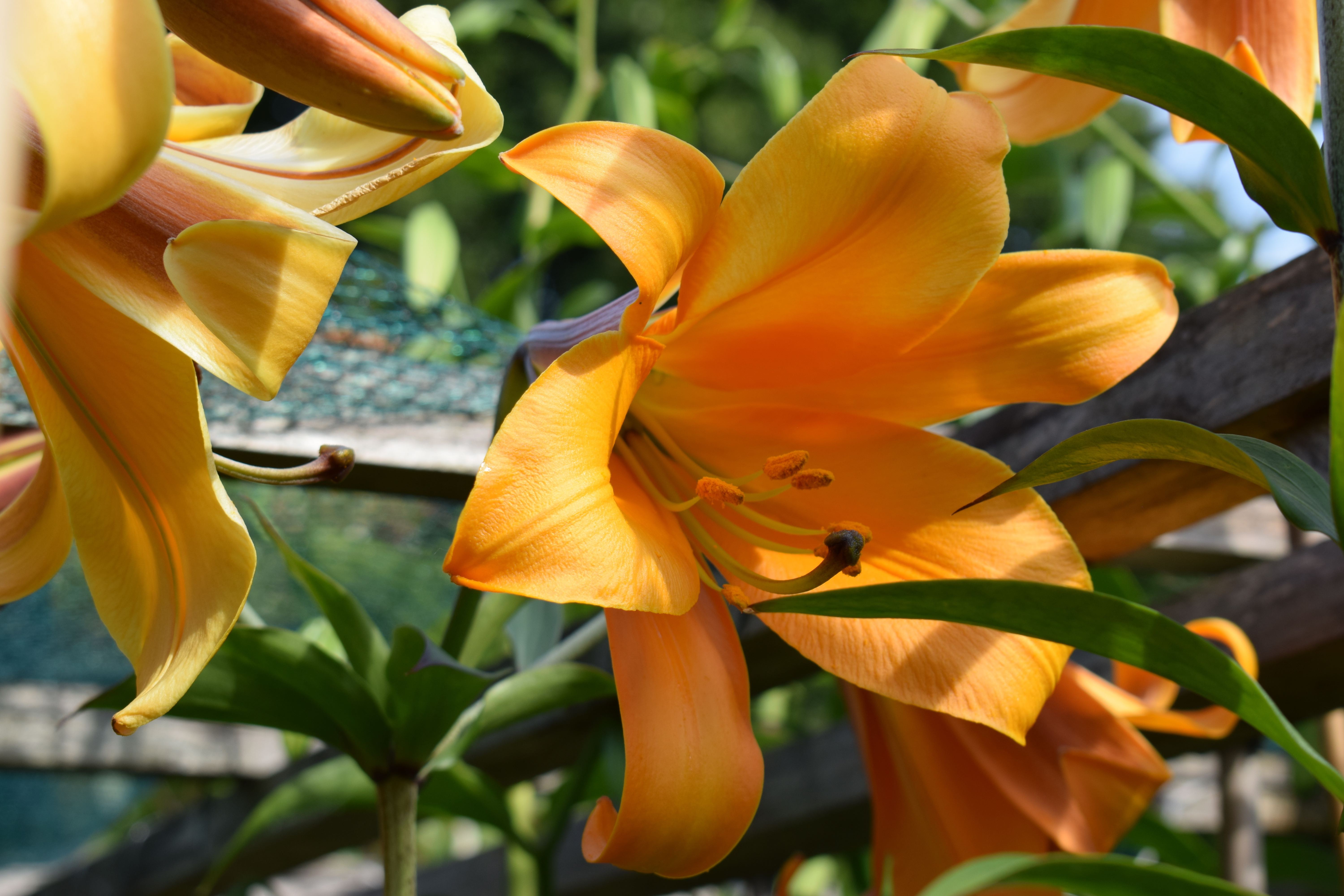
The African Queen lily is another award-winning flower. In 2002, the Royal Horticultural Society awarded the African Queen with the “Award of Garden Merit”.
Compared to other types of lilies, this Trumpet lily’s blossoms are quite big. The African Queen lily produces flowers that are 6 to 8 inches wide. These blossoms are trumpet-shaped and usually face downward. The petals are bright orange to yellow, with brown along the outside.
Each stem produces 15 to 20 flowers, and they bloom in mid-late summer. African Queen lilies make great border plants because their warm color blends well with other types of flowers.
Unfortunately, cat owners will have to opt for another lily as the African Queen is toxic to cats.
Golden Splendor

This next Trumpet lily lives up to its name. The Golden Splendor lily is a large, trumpet-shaped flower in the shade of a vibrant yellow. It blooms facing outward and has brown hues shading the outside of its petals.
The Golden Splendor lily is also prolific, with 12 to 20 blossoms per stem. Each flower measures around 6 inches wide. Its size, color, and shape all make it a sight to behold, making it a popular border plant in the summer.
Compared to other types of lilies, the Golden Splendor is more tolerant of dry soil. However, Golden Splendor lilies bloom best under full sun and in moist well-drained soil.
Pink Perfection
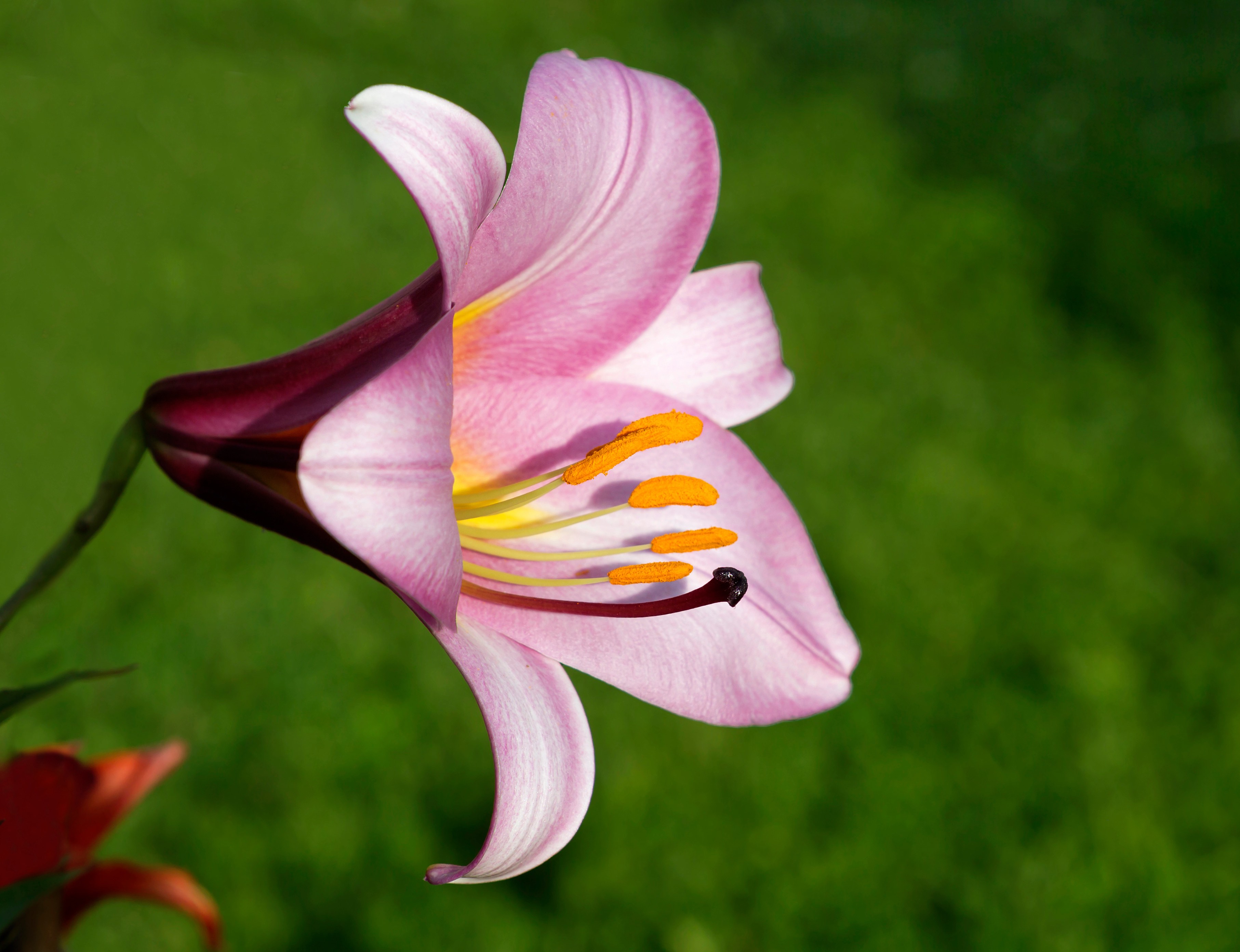
If you’re looking for a pink flower for your garden, then look no further than the Pink Perfection lily! The Pink Perfection lily is the perfect shade of pink, with purple hues around the outside.
Each stem grows up to 4 to 6 ft. tall and produces around 12 to 20 flowers. Clustered together, the Pink Perfection lily is perfect for gardens, ornaments, and cut flowers.
Unfortunately, Pink Perfection lilies are toxic to cats. They also attract lily leaf beetles, which can damage your plants. These are some important things to consider before buying bulbs of these lilies.
Candidum Hybrid Lilies
This next division is relatively small as it has fewer types of lilies than most groups. However, fewer numbers do little to affect the Candidum hybrid division’s relevance in society.
The first mention of a lily dates back to 4,000 years ago, with a reference to a pure white Candidum hybrid. This specific Candidum hybrid is the Madonna lily, which is one of the most popular lilies in this division. Historians also discovered artifacts depicting the Madonna lily in Ancient Greece, Crete, and Mesopotamia.
Today, Candidum lilies continue to be popular and loved, especially in the commercial market. Aside from their strong fragrance, Candidum lilies are usually pure white, making them a favorite choice for formal events.
June Fragrance
Compared to most types of lilies, the June Fragrance lily is an early bloomer. June Fragrance lilies bloom around late spring to early summer. Its blossoms are creamy white, which makes them easy to include in flower arrangements.
As its name suggests, the June Fragrance has a strong, sweet smell. These qualities all make June Fragrance lilies popular choices for bouquets and ornaments.
Despite being a relatively new hybrid, this lily has already been used to create other hybrids as well.
Madonna Lily
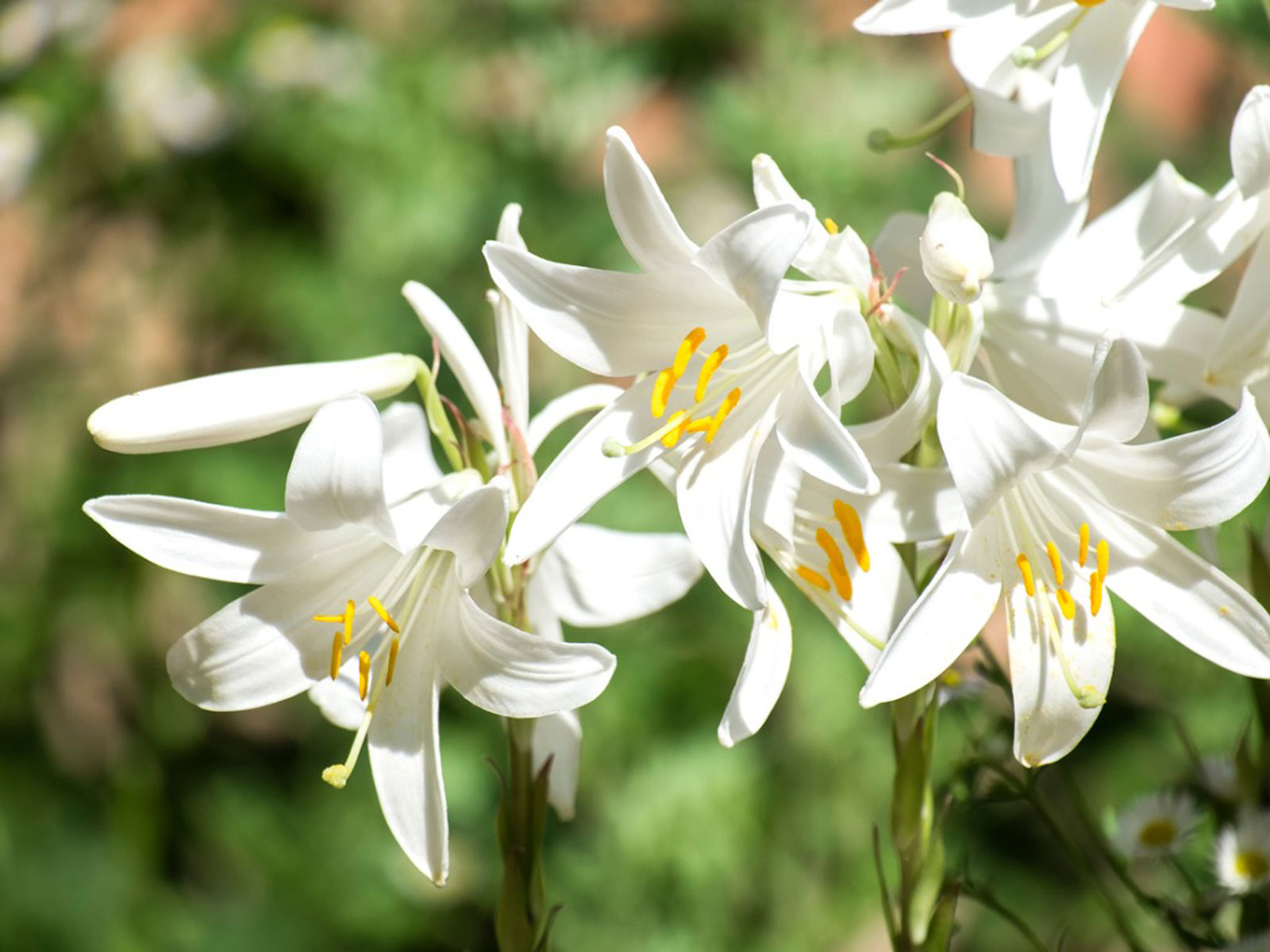
Known to many as the original Candidum lily, the Madonna lily is a large, pure white trumpet with bright yellow pollen. In full bloom, Madonna lilies measure up to 2 to 3 in. wide, and they have a strong scent.
The Madonna lily appears in many historical accounts and paintings. One example is the ancient Minoan painting called Prince of the Lilies. Historians believe the flowers in the fresco are Madonna lilies.
Aside from its historical value, the Madonna Lily is also an important symbol in different cultures and religions. In the Catholic Church, the Madonna Lilly symbolizes chastity and purity. In Taiwan, chefs use the Madonna Lily’s flower and bulbs as ingredients for food.
Unfortunately, the Madonna Lily is susceptible to many plant diseases, such as the Botrytis fungus. According to professionals, growing Madonna lilies from seeds instead of bulbs will help lessen the risks of catching those viruses.
Other names for this flower include “French Lily”, “Juno’s Rose”, “St. Joseph’s Lily”, “Annunciation Lily” and many more.
American Hybrid Lilies
As the name suggests, American hybrids are derived from those native to North America. American hybrid lilies can both survive in warm and cold regions, but they bloom and thrive most in warmer seasons.
Lilies under this division produce flowers that face outwards with recurved petals. Their flowers usually come in colorful shades with spotted patterns. American hybrid lilies are also tall plants, growing up to 7 ft. tall.
Bellingham Lily

From maroon to yellow, Bellingham lilies come in a variety of colors. Each stem grows up to 6 ft. tall and produces around 20 flowers. Bellingham lilies have distinct downward-facing blossoms with upturned petals. Dark red spots also spread across the petals.
Bellingham lilies are quite low maintenance. They are more tolerable to dry soil, but they favor moist soil over anything else. However, regular pruning is necessary to lessen the risks of gray molds.
The Bellingham lily is also toxic to cats. Its pollen can be lethal to these felines, so cat owners will, unfortunately, have to opt for other types of lilies.
Canada Lily

The Lilium canadense, or Canada lily, is native to the meadows of eastern North America. Another name for the Canada lily is “Wild Yellow Lily”. Despite this nickname, however, not all Canada lilies are yellow. Some also have red or orange blossoms.
Canada lilies produce pendant flowers, and they are not as fragrant as other types of lilies. Despite this, Canada lilies are popular ornamental flowers in Europe. In North America, indigenous peoples eat the buds and roots of Canada lilies.
Unfortunately, the Canada lily is considered Exploitably Vulnerable in New York and Rare in Indiana. This hybrid attracts a lot of deer, which has also contributed to the lily’s declining numbers in the wild.
Leopard Lily

Out of all the types of lilies, Leopard lilies are the tallest. This lily plant can grow up to 8 ft. tall! With that height, it’s certainly difficult to miss these pink lilies. Its petals have yellow or orange centers and brown spots all over.
You’ll find wild Leopard lilies in wet regions of California and the Sierra Nevada mountains. Leopard lilies prefer wet soil, and they can also grow in shaded areas. This hybrid has several subspecies, such as the Pitkin Marsh lily, Shasta lily, and Wollmer’s lily.
Another name for the Leopard lily is “Panther Lily”. This is also the name of a character in the popular anime franchise, Fairy Tail.
Interdivisional Hybrid Lilies
Some types of lilies come from crossing plants from different divisions. These hybrids fall under the Interdivisional hybrid division. For instance, LA hybrids come from crossing Longiflorum lilies with Asiatic lilies. On the other hand, OT lilies, or Orienpet lilies, come from crossing Oriental lilies with Trumpet lilies.
Because they come from different types of lilies, the hybrids in this group have distinct characteristics. Some are fragrant, while some are not. Some produce large flowers, while some do not.
One thing the lilies under this group have in common, however, is they are new hybrids. Today’s science has made crossbreeding lilies possible, resulting in more types of lilies.
Altari Lily
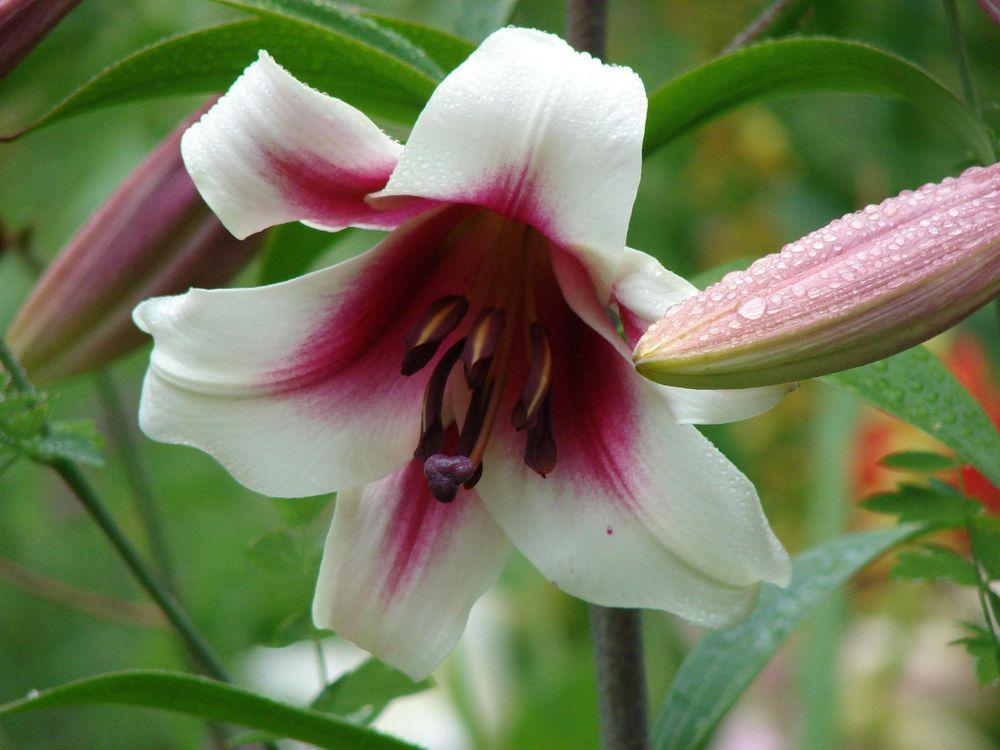
This Orienpet lily has large, star-shaped blossoms. Altari lilies are dark pink flowers, with white edges on their petals. Like most types of lilies, Altari lilies thrive best under the full sun. This hybrid favors acidic soils, and it is great for both garden beds and borders.
As an interdivisional hybrid, Altari lilies are less prone to catching diseases. They can also tolerate both cold and hot climates. This makes Altari lilies great choices for those who live in areas with moody weather.
Unfortunately, crossbreeding did not resolve its toxicity. Altari lilies will harm your feline companions, so it’s best to keep this hybrid away from them.
Anastasia Lily
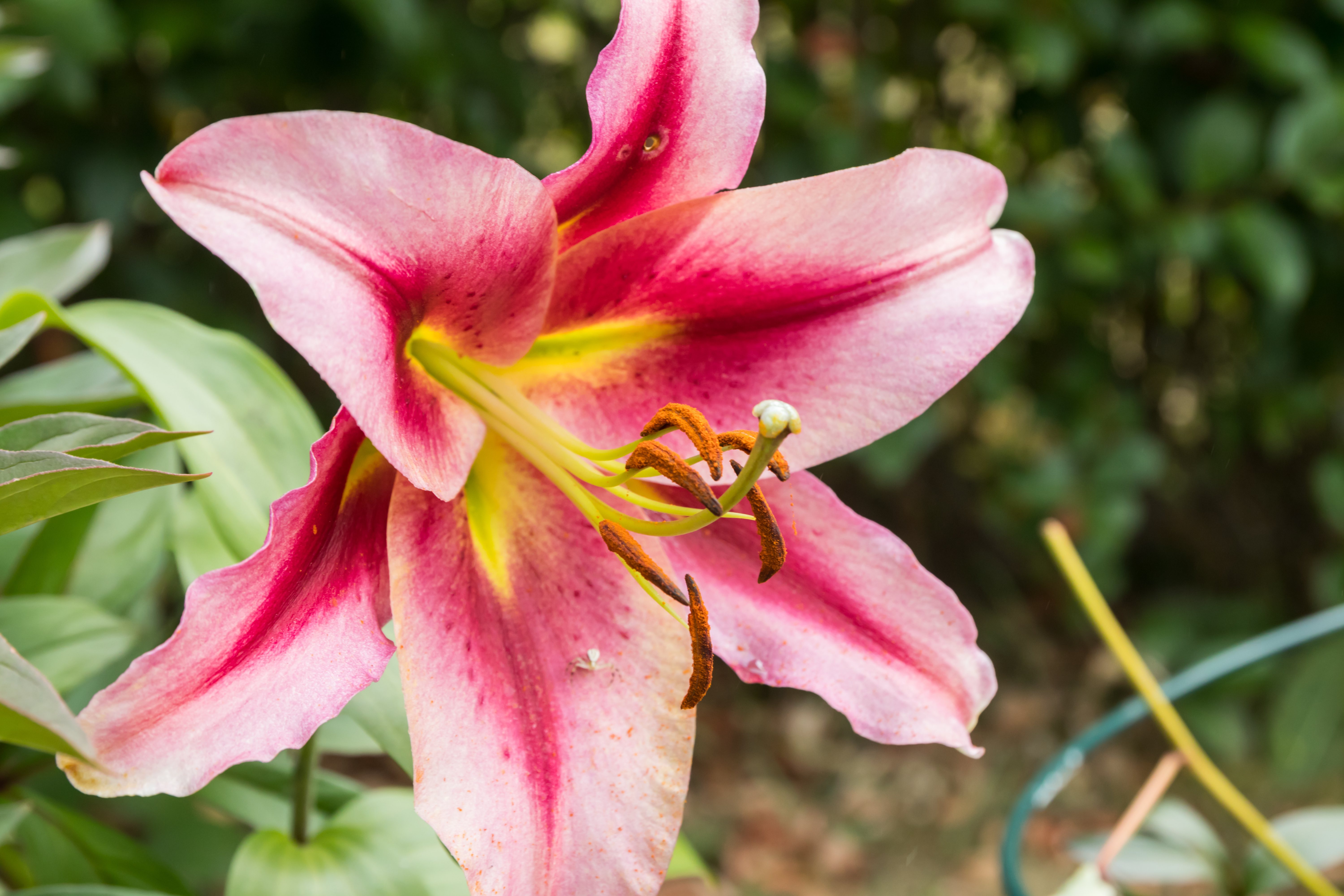
Another Orienpet lily on this list is the Anastasia lily. Anastasia lilies are large, pendant flowers. The petals are pink to the center but fade out to a delicate white toward the tips.
Anastasia lilies have sturdy stems that grow up to 4 to 7 ft. tall. This hybrid is prolific, with each stem producing 20 to 30 blossoms per stem. These flowers bloom toward the end of summer, so timing them with other types of lilies can be tricky.
Aside from bees and butterflies, the Anastasia lily also attracts hummingbirds. That’s certainly another way the Anastasia lily brings life to a garden!
Belladonna Lily
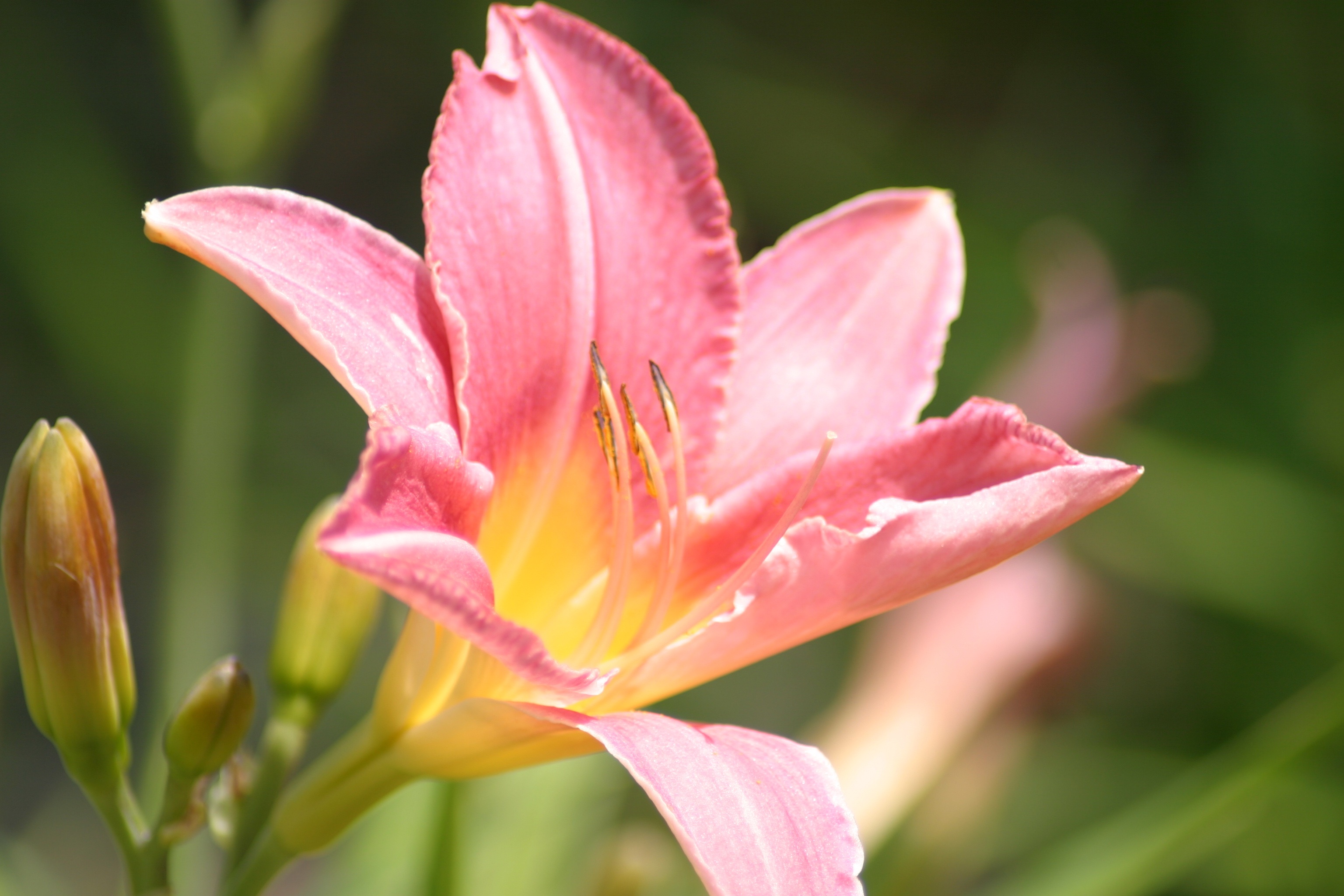
This next hybrid has another curious name. People also call Belladonna lily the “Naked Lady lily” because of its bare stems. The Belladonna lily’s stem is also purplish-red to green and only grows up to 2 to 3 ft. tall.
Belladonna lilies are very low maintenance, and they can grow in varied regions. They do well in containers, borders, and even rock gardens! One important note about these lilies is that all of their parts are poisonous.
Like other types of lilies in its division, this lily is less prone to catching diseases. However, they are not immune to pests, such as mites, spiders, and mealybugs.
Black Beauty Lily

Among the different types of lilies, the strongest might just be the Black Beauty lily. The Black Beauty lily has a strong, sturdy stem that grows up to 8 ft. tall. Each stem produces 50 to 150 flowers. Despite such a tall height and a heavy cluster, the Black Beauty does not need any support.
Black Beauty lilies are also long-lasting, and they are easy to grow. These qualities make them a favorite for many gardeners. In fact, many gardeners call the Black Beauty “indestructible”.
It also lives up to its name of Black Beauty. Its blossoms are dark crimson, with white or silver edges. The recurved petals make it easy to see the Black Beauty’s green center, shaped like a star.
Species and Cultivars of Species
This last division comprises the wild lilies or the parents of the hybrids in the other divisions. Wild lilies are native to the Northern hemisphere, namely North America, Europe, and Asia.
Despite surviving well in the wild, most native species are difficult to tend to in gardens. Wild lilies thrive in temperate climates, and they propagate from their seeds. This is something to consider if you’re thinking of growing wild lilies in your garden.
Tiger Lily
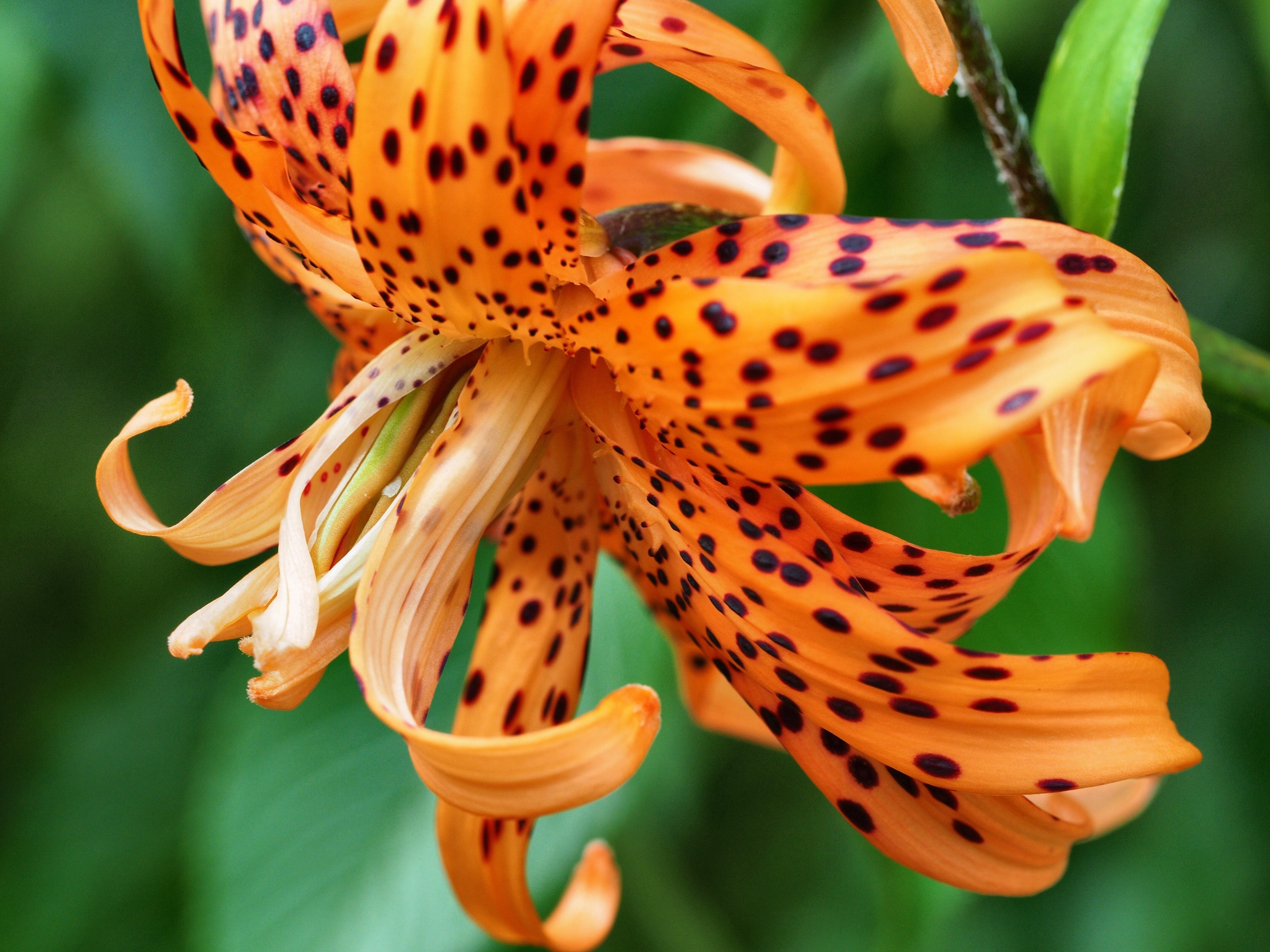
The Tiger Lily is one of the most popular types of lilies in the world. This showy flower is a vibrant orange with black spots. Hybrids of the Tiger Lily also exist, and they come in different colors such as white and pink.
Because of its eye-catching appearance, most plant nurseries cultivate Tiger lilies for ornamental purposes. It is popular in North America and New England. This true lily, however, is native to Asia, particularly China, Japan, Korea, and the Russian Far East.
While a case study found a successful treatment for a cat that ingested tiger lilies, cat owners should still be careful about letting their pets near these lilies.
A character in a famous children’s book and play, Peter Pan, has the same name. In the story, Tiger Lily is the feisty daughter of the chief of a Native American tribe.
Regale Lily
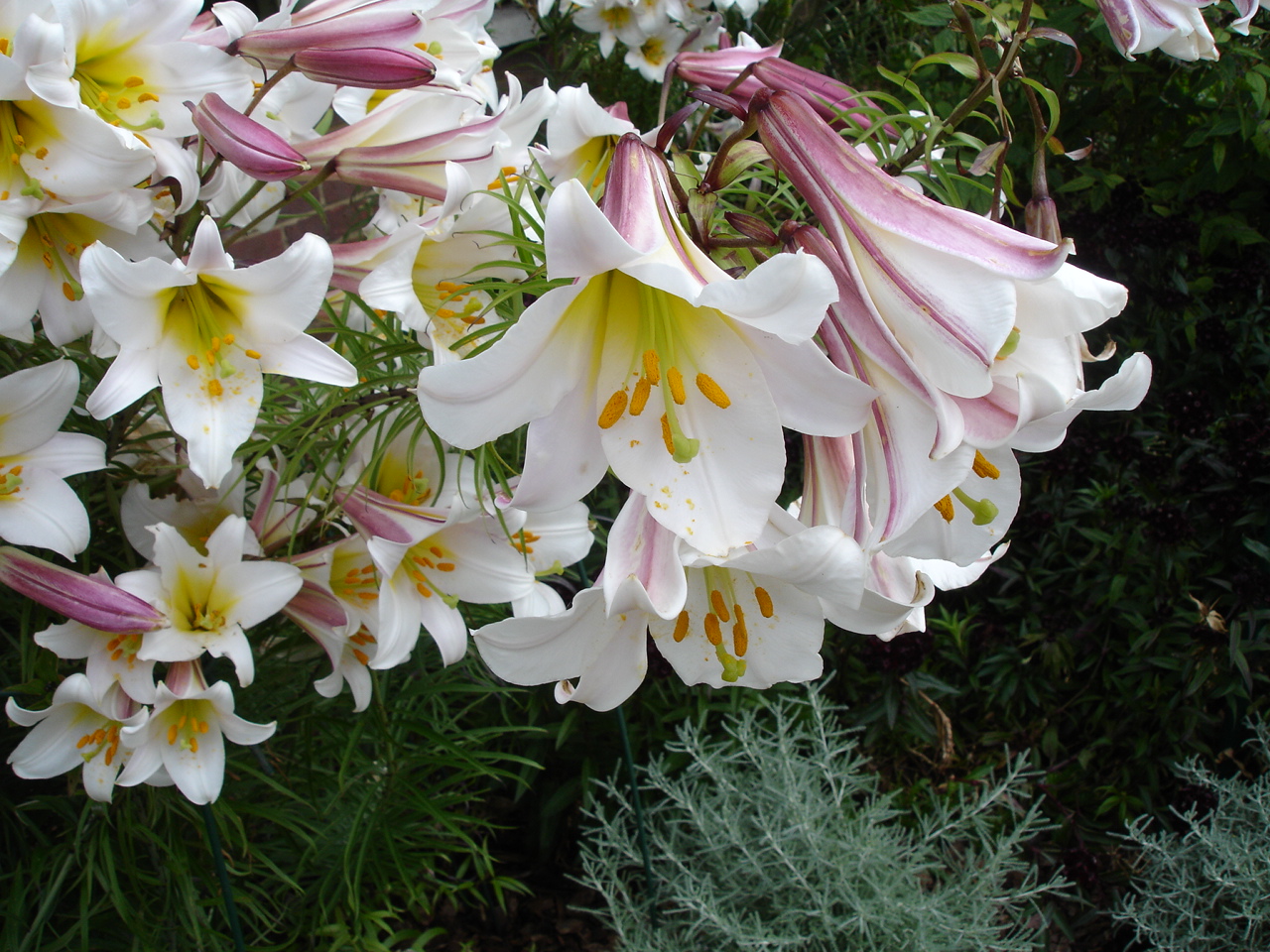
The Regale Lily, sometimes “Regal Lily”, is a large, pure white trumpet flower. In full bloom, it can measure up to 6 inches wide. It has a golden yellow center and pink streaks along the outside, which further emphasize its white petals.
A Regale lily’s stem is rigid, leafy, and can grow up to 6 ft. tall. Each stem can produce up to 25 blossoms. Whether it’s in a cluster or on its own, the Regale lily gives off an intense fragrance.
Before its exportation in 1903, the Regale lily was a wildflower in southwestern China. Today, it is a popular ornament worldwide. In New Zealand, they even call it the “Christmas lily”.
Other names for the Regale lily include “Royal Lily” and “King’s Lily”.
Was this page helpful?
Our commitment to delivering trustworthy and engaging content is at the heart of what we do. Each fact on our site is contributed by real users like you, bringing a wealth of diverse insights and information. To ensure the highest standards of accuracy and reliability, our dedicated editors meticulously review each submission. This process guarantees that the facts we share are not only fascinating but also credible. Trust in our commitment to quality and authenticity as you explore and learn with us.


